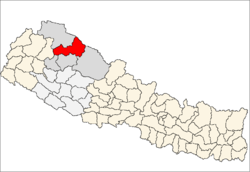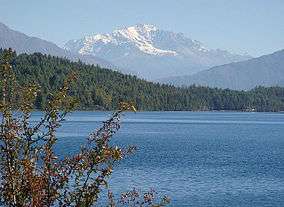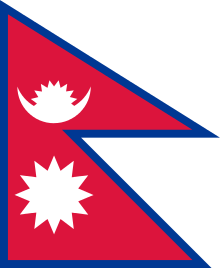Mugu District
| Mugu मुगु | |
|---|---|
| District | |
|
| |
 Location of Mugu | |
| Country | Nepal |
| Region | Mid-Western (Madhya Pashchimanchal) |
| Zone | Karnali |
| Headquarters | Gamgadhi |
| Area | |
| • Total | 3,535 km2 (1,365 sq mi) |
| Population (2011) | |
| • Total | 55,286 |
| • Density | 16/km2 (41/sq mi) |
| Time zone | NPT (UTC+5:45) |

Mugu District(Nepali: मुगु जिल्ला![]() Listen , a part of Province No. 6, is one of the seventy-five districts of Nepal, a landlocked country of South Asia. The district, with Gamgadhi as its district headquarters, covers an area of 3,535 km² and had a population (2011) of 55,286.[1] Mugu is known for being both the most remote district in Nepal, as well as the least developed.
Listen , a part of Province No. 6, is one of the seventy-five districts of Nepal, a landlocked country of South Asia. The district, with Gamgadhi as its district headquarters, covers an area of 3,535 km² and had a population (2011) of 55,286.[1] Mugu is known for being both the most remote district in Nepal, as well as the least developed.
Geography and Climate
Mugu's geography is very rugged. The biggest lake in Nepal, Rara Lake—also known as Mahendra Daha—lies in Mugu District.
It is one of the biggest districts of Nepal. Pulu is one of the famous Village Development Committee (VDC) of Mugu district. There are many villages in this VDC namely Riusa, Mooh, Mangri, Serog, Dawra etc. Similarly, Seri Village Development Committee (VDC) is one of the famous VDC of the district. It is located to west of Rara VDC.
| Climate Zone[2] | Elevation Range | % of Area |
|---|---|---|
| Subtropical | 1,000 to 2,000 meters 3,300 to 6,600 ft. |
5.6% |
| Temperate | 2,000 to 3,000 meters 6,400 to 9,800 ft. |
19.3% |
| Subalpine | 3,000 to 4,000 meters 9,800 to 13,100 ft. |
20.6% |
| Alpine | 4,000 to 5,000 meters 13,100 to 16,400 ft. |
17.7% |
| Nival | above 5,000 meters | 5.3% |
| Trans-Himalayan[3] | 3,000 to 6,400 meters 9,800 to 21,000 ft. |
31.2% |
Tourism
The remote Mugu district is rich in natural resources. Nepal's largest Rara Lake lies in this district. Many domestic and international tourist come to visit the famous and beautiful Rara Lake. The lake is also known as the Mahendra Tal. The Lake liest at an elevation of 2,990 meters and covers about 10.8 km2 of area. The Rara National Park protects this beautiful Rara Lake.
Village Development Committees (VDCs)
- Bhiyi
- Dhainakot
- Dolphu
- Jima
- Gamtha
- Hyanglu
- Jima
- Kale
- Karkibada
- Kimri
- Kotdada
- Mangri
- Mugu
- Natharpu
- Photu
- Pina
- Pulu
- Rara
- Rara Kalai
- Rowa
- Ruga
- Khamale
- Seri
- Srikot
- Srinagar
- Sukhadhik
References
- ↑ "National Population and Housing Census 2011 (National Report)" (PDF). Central Bureau of Statistics. Retrieved November 2012. Check date values in:
|access-date=(help) - ↑ The Map of Potential Vegetation of Nepal - a forestry/agroecological/biodiversity classification system (PDF), . Forest & Landscape Development and Environment Series 2-2005 and CFC-TIS Document Series No.110., 2005, ISBN 87-7903-210-9, retrieved Nov 22, 2013 horizontal tab character in
|series=at position 91 (help) - ↑ Shrestha, Mani R.; Rokaya, Maan B.; Ghimire, Suresh K. (2005). "Vegetation pattern of Trans-Himalayan zone in the North-West Nepal". Nepal Journal of Plant Sciences. 1: 129–135. Retrieved Feb 7, 2014.
- ↑ Banerji, Gargi; Basu, Sejuti. "Climate Change and Himalayan Cold Deserts: Mapping vulnerability and threat to ecology and indigenous livelihoods" (PDF). Pragya. Gurgaon, Haryana, India. Retrieved February 7, 2014.
- "Districts of Nepal". Statoids.
Coordinates: 29°33′N 82°10′E / 29.550°N 82.167°E
| Wikimedia Commons has media related to Mugu District. |

